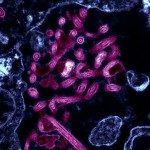Lien vers Pubmed [PMID] – 2221583
Am. Rev. Respir. Dis. 1990 Oct;142(4):782-8
We hypothesized that thrombin activation may play a prominent role in endotoxin-induced secondary organ failure, such as acute lung injury. To test this hypothesis, we administered a thrombin-specific inhibitor, recombinant hirudin, in endotoxemic pigs. The pigs were anesthetized, mechanically ventilated, and prepared with Swan-Ganz and extravascular lung water (EVLW) catheters. A total of 18 randomly selected animals received a pretreatment of 1,000 U/kg of hirudin, followed by a continuous infusion over 6 h of 500 U/kg/h given simultaneously with the infusion of 10 micrograms/kg/h of Salmonella abortus equi endotoxin. Another 18 animals received a continuous infusion over 6 h of endotoxin but did not receive hirudin. All animals were fluid resuscitated with 17 ml/kg/h of saline for the duration of the experiment. Data are expressed as the mean (95% confidence interval). Hirudin reduced the endotoxin-induced consumption of plasma fibrinogen from -110 (-138 to -82) mg/100 ml to -39 (-67 to -12) mg/100 ml (p = 0.0001) and endotoxin-induced increases in the soluble fibrin in plasma from 434 (369 to 499) ng/ml to 236 (171 to 300) ng/ml (p = 0.0002). These data suggest an effective inhibition of the endotoxin-generated thrombin by hirudin. Furthermore, hirudin significantly reduced endotoxin-induced increases in pulmonary vascular resistance from 32 (27 to 37) kdyn x s x cm-5 x kg to 20 (15 to 25) kdyn x s x cm-5 x kg (p = 0.0015) and increases in EVLW from 15.4 (13.2 to 17.6) ml/kg to 12.2 (10.0 to 14.4) ml/kg (p = 0.0299).(ABSTRACT TRUNCATED AT 250 WORDS)

